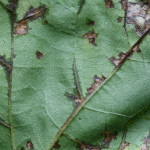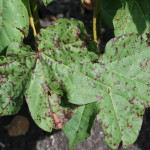By Thomas Isakeit, Professor and Extension Plant Pathologist
Cotton: Bacterial blight, caused by the bacterium, Xanthomonas campestris pv. malvacearum, has been observed in some fields in the Lower Rio Grande Valley and the Blacklands growing areas. The characteristic symptoms are dark brown, angular spots on leaves, confined between veins, often with water soaking (PHOTO 1).Small, circular dark brown spots are also formed (PHOTO 2). Extensive lesions on leaves can result in defoliation. Circular, water-soaked lesions can also occur on bolls (PHOTO 3).
The pathogen is seedborne. Acid-delinting greatly reduces, but does not eliminate, contamination. Cotton varieties differ in resistance, but resistance is usually specific to a particular race of the pathogen. There are many races of the pathogen. The pathogen is specific to cotton and can survive for several months in crop residue. Burial of crop residue will speed the demise of the pathogen. Fields with a severe outbreak of bacterial blight should be rotated to another crop. There are no chemical controls available. However, the severity of the disease is driven by frequent rain during the growing season. Generally, outbreaks in Texas have not been as severe as those in eastern cotton-production states which receive more rain.
Corn: Southern rust has been observed at several locations in the Upper Coast growing area. This disease is also driven by frequent rain during the growing season. The need to apply a fungicide to prevent yield loss is determined by the crop stage and the severity of the disease within the field. Some late-planted corn may be at risk for losses from this disease. This publication provides guidance on when to spray: http://aglifesciences.tamu.edu/plantpathology/wp-content/uploads/sites/19/2011/05/Southern-Rust-of-Corn_2014.pdf.
Soybean: Soybean rust has been detected in some fields in the Lower Rio Grande Valley. Fields north of this area, particularly in the Upper Coast counties, should be scouted. A fungicide is likely to have the greatest benefit for preventing loss from this disease if applied between R1 and R5. The national website, www.sbrusa.net, can give a “heads up” for an advisory of spraying or waiting to spray. This publication provides more information about soybean rust, as well as other common diseases of soybean in the Upper Coast and Lower Rio Grande Valley: http://agrilife.org/plantpathology/files/2011/11/Soybean_diseases.pdf.
Sorghum: There are several fungicides that are labeled for control of foliar diseases of sorghum, but this doesn’t mean that they are needed under Texas conditions, including even this growing season when there’s been so much rain. I have done several years of small-plot trials, where I’ve inoculated the plots with the anthracnose pathogen and in only one of those years have I seen a yield increase in association with disease control. I have never seen more than a trace amount of anthracnose in commercial fields in the Upper Coast counties, an area of Texas that I consider to be the most conducive to leaf diseases caused by fungi. Other fungal diseases are usually at very low levels, as well, and I wouldn’t be concerned about potential yield losses from that level of severity. I followed large-scale field trials of fungicides conducted by Dan Fromme and Stephen Biles. There was trace or no disease in those trials and neither of them reported an increase in yield with the use of a fungicide.
If you have any questions, contact me at (979) 862-1340 or t-isakeit@tamu.edu.



